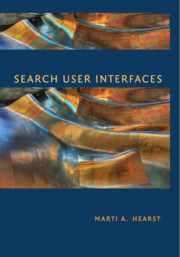Book contents
- Frontmatter
- Contents
- Preface
- 1 The Design of Search User Interfaces
- 2 The Evaluation of Search User Interfaces
- 3 Models of the Information Seeking Process
- 4 Query Specification
- 5 Presentation of Search Results
- 6 Query Reformulation
- 7 Supporting the Search Process
- 8 Integrating Navigation with Search
- 9 Personalization in Search
- 10 Information Visualization for Search Interfaces
- 11 Information Visualization for Text Analysis
- 12 Emerging Trends in Search Interfaces
- Appendix: Additional Copyright Notices
- Bibliography
- Index
- Author Index
- Plate section
9 - Personalization in Search
Published online by Cambridge University Press: 05 March 2013
- Frontmatter
- Contents
- Preface
- 1 The Design of Search User Interfaces
- 2 The Evaluation of Search User Interfaces
- 3 Models of the Information Seeking Process
- 4 Query Specification
- 5 Presentation of Search Results
- 6 Query Reformulation
- 7 Supporting the Search Process
- 8 Integrating Navigation with Search
- 9 Personalization in Search
- 10 Information Visualization for Search Interfaces
- 11 Information Visualization for Text Analysis
- 12 Emerging Trends in Search Interfaces
- Appendix: Additional Copyright Notices
- Bibliography
- Index
- Author Index
- Plate section
Summary
Currently most Web search engines produce the same results independently of who the user is; search engines are in fact designed to do well at meeting the average goals of the group over the specific goals of the individual (Teevan et al. 2005a). Nonetheless, researchers, marketers, and search pundits alike often state that search results should reflect the fact that people differ in their needs, goals, and preferences (Pitkow et al. 2002). As a typical example, an avionics expert should see a different results ranking for a query on jets than a football fan from New York.
Tailoring search results to an individual's interests is just one form of information personalization. The term is currently applied to a diverse array of information applications. Given a profile of a user's interests, information content can be personalized by: re-ranking search results listings to better reflect the user's preferences, automatically notifying a user when new articles of interest appear or important changes are made to existing documents, recommending items that are related in some way to an item currently being viewed, and customizing the look and content of a Web site or other information artifact.
Information personalization approaches vary along several dimensions. Some make use of information that users explicitly specify about themselves and their interests, while others attempt to infer users' preferences implicitly from their actions. Some approaches note that individuals tend to have both long-term, stable interests, and short-term temporary interests, and that these can come into conflict when proposing recommendations based on past actions.
- Type
- Chapter
- Information
- Search User Interfaces , pp. 211 - 233Publisher: Cambridge University PressPrint publication year: 2009



